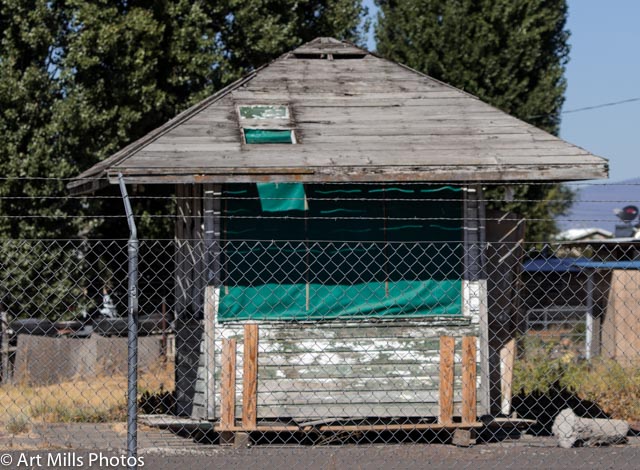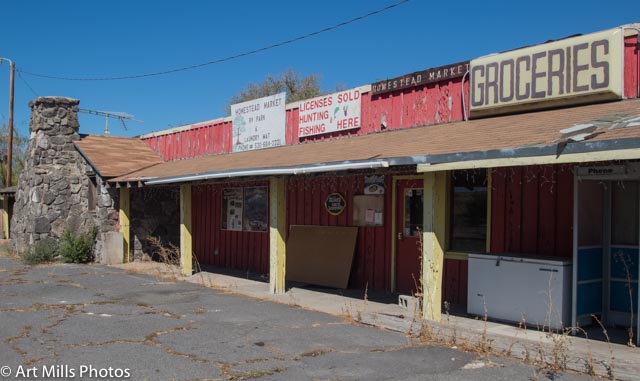JOURNEY of CONSCIENCE
Visiting the WWII Japanese American Internment Camps
Mysteries…
One of the most interesting things about the Tule Lake Camp concerns things that are NO LONGER VISIBLE…or, REMNANTS of things that are long gone… There are Mysteries to unpack and Stories to tell.
Remnants of buildings and structures can be found all over the site of the Tule Lake WRA Camp. Some are in plain sight…if you recognize what they are. Others are more illusive. Often, you need to cross a fence in order to find them.
Come with me on this part of the journey…this pursuit of mysteries and stories.

This is a wide view of the Tule Lake Camp in 1943. Roads filled the Camp in a city-grid pattern, connecting the barracks blocks and the administrative areas. The roads were everywhere. [Source: Library of Congress]

If you wander, ignoring the fences, you’ll find a patchwork of the old roads. Here is the remnant of a road heading East, near the airport.
Somebody doesn’t want you to wander out here. The Tulelake Airport folks, with the apparent backing of the FAA, are planning to erect an eight foot fence out there. It would cut off access to about half of the former WRA Camp. Some people suggest it is a matter of national security. What?… there is no one out there… there are hardly any airplanes taking off or landing. In four days of visits (weekdays and weekends), I never saw one airplane using the airport. Is the fence to stifle curiosity and memory? When I wander out in these fields, on these roads, I imagine the hundreds of thousands of interactions that took place among the people who were taken to Tule Lake. Shouldn’t we be about discovery instead of covering things up?
The remnants of the roads are there, but look in the first picture in this post… it is filled with barracks. Where did those barracks go? There was housing for 16,000 people in that picture. Where are they now? It’s actually a mystery that is easily solved. After WW II, the federal government decided to give a group of returning veterans the use of the barracks and the agricultural land from many of the WRA Camps. In the case of Tule Lake, the government conducted a lottery for returning GIs. The winners each received 80 acres of former camp land for a farm, and the right to 1 1/2 barracks for a home and an out building. It was the last use of the Homestead Act (from the post-Civil War era).
In my previous post, I mentioned meeting a man who farmed for 20 years on former Camp land. He had purchased his 80 acre farm and house from a WW II veteran who had homesteaded the land and who was retiring from farming. The man I met lived in a house converted from one of the Camp barracks. Mystery solved… By the way, that man expressed the hope that the NPS would find one or two of the barracks and transport them back to the Camp for restoration.
Across another barbed wire fence, on Tulelake Airport land, I found this foundation for what was called a Bathhouse at the Tule Lake WRA Camp. At the near end, are two rows of holes in the concrete floor. These were for the toilets, which were separated by a three foot high partition. At Tule Lake, there was an efficiency of construction in that each Bathhouse building had a men’s latrine and shower at one end and a women’s latrine and shower at the other, with a boiler room in the middle.

The next photo shows a linkage of the underlying Camp infrastructure.

This telephoto image shows the foundation of a bathhouse with the Imhoff Tank sewage treatment facility in the background. Each Block of 14 barracks buildings was served by one Bathhouse building. There were at least 74 such Bathhouses in the Camp, not including those for the MP s and administrative staff. They were all connected to the Imhoff Tank via sewer pipes. I have no idea where those buildings went, but I do know where the underlying pipes are…in the ground. Let’s go back above ground to look at one of the most prominent aspects of the Tule Lake WRA Camp.
This is a 1942 technical drawing for the design of the Guard Towers at Tule Lake.
[Source: the National Archives]

Tule Lake started out with 6 of these towers. When the Camp was turned into a maximum security prison camp for people who were supposedly disloyal to the United States, the number of guard towers increased to 28.

This is a remnant of one of those 28 towers. I found it in the Camp Motor Pool area, behind the Caltrans Maintenance yard. Oh, what range of emotions just the sight of such a tower must set in motion. There was surely mix of veterans and rookies who manned these towers as armed guards. For most people in the Camp, the towers were stern reminders that this was a prison Camp. For some of the kids in the Camp, the towers represented a chance for high stakes playfulness…
“…they had a main fence here, they had a little fence, a warning fence, and what we used to do is a bunch of us guys go there, the guard towers every three hundred feet, so that’s we used to do. Run up by that warning fence, we’d stand there and the MP would get excited, then we’d give him a one-finger salute and we’d walk… [laughs]. But the best thing is that, we used to, another thing, we used to go over there and jump on the other side, “We’re just going to the other side of that fence,” because it’s low, you could jump over there. We’d go over there, and boy, the MP get by, and pretty soon we’d see the dust flying and we knew a jeep or somebody coming with a jeep, so we’d just go on the other side, and once we got on the other side, we scattered. Hell, they didn’t know who in the hell we were. We all look alike, so they didn’t know. But if you’re incarcerated, you do anything to get after the authority as per se.”
Taketora Jim Tanaka, age 16 in Tule Lake
The worst remnant involves a desecration. It is a mystery that I have been unable to fully resolve.

This photo was taken near the Southwest corner of the Camp. It is where the Camp cemetery was. What remains is an area that was obviously excavated… Barbara Takei and Judy Tachibana have written the most accessible book about Tule Lake, entitled “Tule Lake Revisited: a brief history and guide to the Tule Lake Concentration Camp Site.” The authors suggest that the former cemetery was dug up with bulldozers (human remains and all) and used as fill for construction projects elsewhere in the area [Tule Lake Revisited, p. 40]. Most of the 10 WRA Camps have small cemeteries with monuments to those who died in captivity. Here there is nothing. What exactly happened? Where was the construction site to which the earth and remains were taken? Who decided to do this? What local or federal government official allowed this to happen or approved the action? What dark motivation drove this act of desecration? These questions cry out for an answer.
The Newell Homstead Market is out of business. It is a sprawling, old building on State Highway 139, in front of where the Tule Lake Camp Hospital was. What is not apparent is that this old building served as the Recreation Center for Tule Lake Camp staff.


Prisoners at the Tule Lake Camp built the rock fire place that fronts the building.
So, most of the mysteries are solved. One requires some more answers. All of the remnants lead to more questions: What will become of this area? With so much undeveloped land around the former site of the Tule Lake Camp, and with so many remnants in place or close by, how much historical restoration of the Camp will the National Park Service be able to accomplish with its limited budget?
There is one more stop on my visit to the Tule Lake WRA Camp. Next time, we’ll look at the Stockade and the Jail that were a central part of the conversion of Tule Lake from a “Normal” WRA Camp into the maximum security prison camp for the the WRA Camp system.
Thanks for joining me on my journey. I sincerely hope that it has been worthwhile. I deeply appreciate your coming along for the ride.
Grace and peace to you,
Art
Well done, thou good and faithful friend.
LikeLike
You are so kind!
LikeLike
I was disappointed to learn that it was reported in a book by two women, former residents at Tule Lake, that the cemetery of Japanese dead was desecrated and the soil and bodies used as fill dirt in construction projects.
LikeLike
It is truly an unspeakable desecration. Hard to include in my post, but I felt that I must. I want to dig more, to find out exactly what happened…
LikeLike
The land seemed so barren. How many homesteaders actually resided on the land and actually farmed it following WW2?
LikeLike
Of that I’m not sure… They were 80 acre parcels. My impression is that following the war there were hundreds of farmers in the basin. Now, there are 12 farming companies. This is another one of those mysteries about which I will keep seeking information. Probably not too difficult to find.
LikeLike